A stone tool is, in the most general sense, any tool made either partially or entirely out of stone. Although stone tool-dependent societies and cultures still exist today, most stone tools are associated with prehistoric cultures that have become extinct. Archaeologists often study such prehistoric societies, and refer to the study of stone tools as lithic analysis. Ethnoarchaeology has been a valuable research field in order to further the understanding and cultural implications of stone tool use and manufacture.

A hand axe is a prehistoric stone tool with two faces that is the longest-used tool in human history. It is made from stone, usually flint or chert that has been "reduced" and shaped from a larger piece by knapping, or hitting against another stone. They are characteristic of the lower Acheulean and middle Palaeolithic (Mousterian) periods, roughly 1.6 million years ago to about 100,000 years ago, and used by Homo erectus and other early humans, but rarely by Homo sapiens.

Acheulean, from the French acheuléen after the type site of Saint-Acheul, is an archaeological industry of stone tool manufacture characterized by the distinctive oval and pear-shaped "hand axes" associated with Homo erectus and derived species such as Homo heidelbergensis.
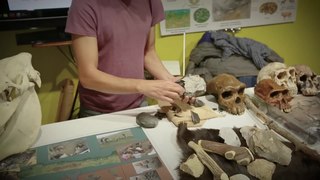
In the archaeology of the Stone Age, an industry or technocomplex is a typological classification of stone tools.
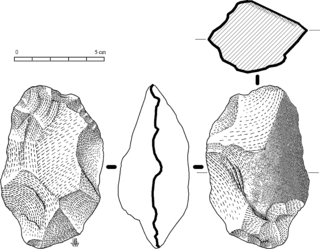
Abbevillian is a term for the oldest lithic industry found in Europe, dated to between roughly 600,000 and 400,000 years ago.

Swanscombe /ˈswɒnzkəm/ is a village in the Borough of Dartford in Kent, England, and the civil parish of Swanscombe and Greenhithe. It is 4.4 miles west of Gravesend and 4.8 miles east of Dartford.
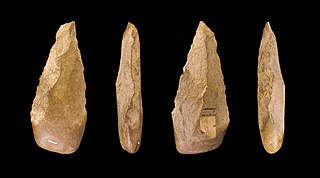
The Lower Paleolithic is the earliest subdivision of the Paleolithic or Old Stone Age. It spans the time from around 3.3 million years ago when the first evidence for stone tool production and use by hominins appears in the current archaeological record, until around 300,000 years ago, spanning the Oldowan and Acheulean lithics industries.
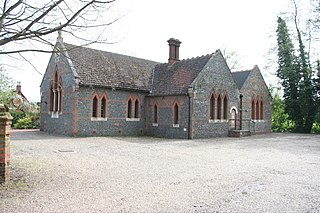
Hoxne is a village in the Mid Suffolk district of Suffolk, England, about five miles (8 km) east-southeast of Diss, Norfolk and 1⁄2 mile (800 m) south of the River Waveney. The parish is irregularly shaped, covering the villages of Hoxne, Cross Street and Heckfield Green, with a 'tongue' extending southwards to take in part of the former RAF Horham airfield.

Archaeologists define a chopper as a pebble tool with an irregular cutting edge formed through the removal of flakes from one side of a stone.

Barnham is a village and civil parish in the West Suffolk district of the English county of Suffolk about 3 miles (4.8 km) south of Thetford and 9 miles (14.5 km) north of Bury St Edmunds on the A134. The village of Euston is 1 mile (1.6 km) to the east. According to the Swedish scholar Eilert Ekwall, the name of the village means "Beorn's homestead".

A ficron handaxe is the name given to a type of prehistoric stone tool biface with long, curved sides and a pointed, well-made tip. They are found in Lower Palaeolithic, Middle Palaeolithic and Acheulean contexts, and are some of the oldest tools ever created by humans. The tool was named by the French archaeologist François Bordes.

In archaeology, a cleaver is a type of biface stone tool of the Lower Palaeolithic.
In archaeology a chopper core is a suggested type of stone tool created by using a lithic core as a chopper following the removal of flakes from that core. They may be a very crude form of early handaxe although they are not bifacially-worked and there is debate as to whether chopper cores were ever used as tools or simply discarded after the desired flakes were removed.
John James Wymer, was a British archaeologist and one of the leading experts on the Palaeolithic period.
The prehistory of the County of Norfolk, England is broken into specific time periods, these being Palaeolithic, Mesolithic and Neolithic.

Swanscombe Skull Site or Swanscombe Heritage Park is a 3.9-hectare (9.6-acre) geological Site of Special Scientific Interest in Swanscombe, north-west Kent, England. It contains two Geological Conservation Review sites and a National Nature Reserve. The park lies in a former gravel quarry, Barnfield Pit.

Baker's Hole is a 6.9 hectares geological Site of Special Scientific Interest, mostly consisting of a back-filled quarry, adjacent to Ebbsfleet International railway station in Kent. It is a Geological Conservation Review site. It is a nationally significant site for finds during quarrying of Stone Age tools, which are now dispersed among many museums.
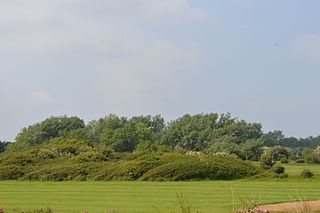
Clacton Cliffs and Foreshore is a 26.1-hectare (64-acre) geological Site of Special Scientific Interest in Clacton-on-Sea in Essex. It is a Geological Conservation Review site.

Hoxne Brick Pit is a 1.3-hectare (3.2-acre) geological Site of Special Scientific Interest in Hoxne in Suffolk, England. It is a Geological Conservation Review site.
Beeches Pit is an archaeological site in Suffolk, England, dated to around 0.4 million years ago. It contains palaeoenvironmental remains, and is particularly notable because it provides evidence of the human use of fire, the earliest in Britain. In addition, knapping debris and Acheulean hand axes have been found. It is one of the richest sites in England for evidence of human activity during that period, and the hand axes are the "earliest post-Anglian handaxe-making horizon in Britain".
















